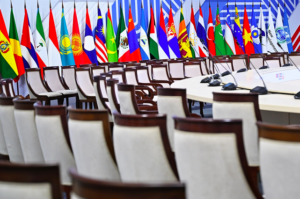This article is a summary of the book “La guerre des puissants. Stratagèmes de domination de la Chine et des Etats-Unis“, co-authored by Catherine DELAHAYE, Pierre-Charles HIRSON, Sylvia GROLLIER and Camille REYMOND, with a foreword by Nicolas MOINET (VA Editions, 2022).
With the help of intelligence methods and reading grids taught at the Paris School of Economic Warfare (EGE – École de Guerre Économique, France), the book “The War of the Powerful” analyzes how the confrontation between China and the US has evolved from a silent transformation to an unabashed assertiveness. It is clearly a true open conflict between two powers, one dominant and installed and the other rising; between two visions and ideologies with opposing values. The two leading world powers ingeniously use all the levers of warlike conquest (strength, tricks, opportunities, interdependencies or persuasions) on the political, economic and societal chessboards.
China and United States of America are the two major economic powers of the early 21st century. However, no one ever imagined that China would one day become the world’s second largest economy right behind the US. And yet, by the end of 2021, some Western journalistic sources considered that China had become the world’s leading economic power, surpassing the US, at least in terms of purchasing power.
China owes its rise to globalization, which made it the world’s biggest manufacturer in the 1990s. Massive relocations of Western factories and companies to China have been accompanied by technology transfers, with more knowledge acquired by China. The short-term vision of seeking maximum profit, especially of the American economy, was thus largely favorable to China’s economic development. Since the new millennium, China has become a key trading partner for many countries and particularly for the US.
The economic confrontation really began to emerge from 2010 onward when China started to become threatening outside its territory. The US, seeing its supremacy challenged on more and more grounds, engaged in several defensive strategies with the idea of slowing down Chinese expansion. The arrival of Donald Trump as President of the US officially marked a stop to this harmonious era of trade globalization, at least for those who think it ever existed, and the outbreak of undisguised economic warfare.
As of now, part of the Western population, including Americans, seems to realize that it is the big loser in this globalization, particularly since the Covid-19 pandemic has placed the economic war between China and the US at the forefront.
Today, China and the US are increasingly forcing their partners and other nations to choose sides in what looks like the beginning of a bipolar world, and more specifically in the digital world. The interpretative frameworks of competitive intelligence used in this book provide a means to shine a light on the mechanisms of these power struggles and to contribute to the systemic understanding of what is at stake in these masked and disguised efforts at domination.
Politics, the heart of the will to increase power
In political matters, the power of a State is the locomotive of hegemonic dynamics, carrying a systemic strategic vision. The power of the tools, structures and bodies resulting from this vision allow the processes to be operationalized.
The American and Chinese political apparatuses are accordingly linking their vision to solid operational tools with global levels of interconnection. These are shaped for and in a logic of power increase. In the US as in China, the power of the public sector is entangled and intertwined in partnerships with the private sector. As a result, economic actors emerge and become mega-leaders in the global marketplace.
The chapter dealing with the political field shows some strategic positions specific to China and the US. These two great nations think about political confrontation and domination with their own tools, adapting them to their style, their identity, their resources and their constraints. However, they seem to share, on the one hand, their ability to think about their approach in terms of ecosystems, and on the other hand, a kind of similarity in the handling of both defensive and offensive visions to maintain and develop their national sovereignty.
The potential of others: how China is redesigning the economic and financial scene built by the US
While the confrontation is indeed political between the US and China, it is also played out in the economic and financial fields. Firstly, war in peacetime has become a matter of confrontation in the digital and economic spheres. Then, the confrontation in a financialized world necessarily involves the control and regulation of monetary flows and their regulatory bodies, as well as the control of markets.
China’s strategy of increasing its power through the economy is guided by the successive plans of the Chinese Communist Party. They outline the priorities for technological and economic developments in the years to come. This long-term vision has enabled China to move from being the workshop of the world to a modern economy. Behind a benevolent discourse, China protects its market while attracting foreign investors.
In response, the American strategy is less concerted and often falls within the time frame of one or two presidential mandates. President Obama sketched out what could have been a long-term policy with his plan for a “pivot to Asia”, but he failed to unite around the Trans-Pacific Partnership which should have been an economic encirclement of China. The reaction was brutal when Donald Trump took radical measures to protect American companies: a tariff war, new legislation, the opening of new partnerships -especially with India and Japan- to offer alternatives to the Chinese Belt and Road Initiative. President Biden seems to be taking a harder line than Barack Obama but one that is less confrontational than Donald Trump.
A territorial and military conflict increasingly accepted
The case of Taiwan is a central element in the territorial and military conflict between China and the US. After an attempt to bring the two countries closer together in 2009, with a G2 project, or the Chimerica, the sale of military equipment to Taiwan for 6.4 billion USD complicated their relationship. A few months later, the meeting between Barack Obama, then President of the US, and the Dalai Lama permanently strained the Sino-American relationship and marked a decisive turning point. In protest at what Beijing saw as interference, the US ambassador to China was summoned. Given the extent of the tensions, Hillary Clinton initiated the project of “pivot to Asia” in 2011, which aimed to shift towards Asia as the diplomatic, economic and military center of gravity.
This chapter studies how this shift materializes, how the evolution of military positions on both sides will interact, and finally how the attempts of destabilization to separate the peoples within nations are orchestrated in order to try and weaken each other.
R&D and technology, the new weapons of a silent war
China and the US are convinced that having a technological lead will allow them to dominate and impose their hegemony on the international system.
The recent events of the limitation for American companies to sell semiconductors to Chinese companies, the banning of Huawei in 5G networks, or the announcement of American space programs to fly to the Moon or explore Mars, are all examples of the American reaction against a threat to their technological superiority. And by extension, a threat to their military and ideological supremacy.
However, one needs a strategy to develop technologies and innovate and thus create a prosperous ecosystem:
- An efficient scientific education system;
- Efficient research structures;
- Industrial capabilities of transforming theoretical knowledge into goods or services;
- Structures to finance R&D and to invest in the means of production;
- An intellectual property system to protect its innovations;
- A capacity to define standards;
- And the will to foster a culture of innovation.
This chapter analyzes all the strategies set up by Chinese and American actors, with a particular focus on their university and R&D systems.
Soft power confrontation: soft power but tough battle
The socio-cultural field is intrinsically part of the overall approach to systemic economic warfare.
Soft power, as defined by Joseph Nye, comprises three components: seduction (or attractiveness), the ability to organize the international agenda and the weight that one can put in the decisions taken (cooptation). Thus, under an innocent appearance, the soft power tools of the two great powers confront each other and engage in a tough battle.
One of the elements of soft power is intangible capital, the brand image of a country, its values and its companies, which are an essential resource to defend and promote.
This chapter describes some of the instruments of influence and information warfare that China and the US use to dominate minds, increase their influence and undermine that of the other: think tanks and associations, the media and social networks, the 7th art, video games and sports are covered in a non-exhaustive manner.
Mobile telecommunications technologies, a mere digital silk road or the Sino-American battle for world domination
The confrontation in the telecommunication technologies is examined in the last chapter of the book, clearly showing the game of the actors on all tangible and intangible grounds.
Telecommunications have become the major theme of confrontation between the US and China. Through this technological leadership, of which consumer mobile telecommunications are only the visible facet, China is aiming for world supremacy by ousting the US and, thereby, the values it carries in political, economic and societal matters.
Telecommunications networks hold a critical central place, all the more visible since 2020 and the health crisis which demonstrates their vital importance, especially for the continuity of public, commercial and private activities.
This chapter aims to highlight some of the issues at stake in these technologies, through the clashes and interdependencies between the US and China. A myriad of actors cross, confront each other, intertwine and interact on both sides of the political, economic and societal chessboards. However, the strategies pursued by China and the US seem very similar: legal and fiscal contest, trade and normative fight, information warfare and influence games with their respective allies and enemies.
Conclusion
China and the United States are hence engaged in a relentless war to conquer or maintain their dominant position.
Both countries have in common a systemic and offensive vision of the different power relations expressed on the world chessboards, in order to defend their interests, but also to attack and conquer dominant positions in the world.
This confrontation is fluctuating and multifaceted. It is played out on all the battlegrounds which are necessary for an increase in power: political, economic, military, technological and socio-cultural. A confrontation that sometimes takes place using n parallel tracks or in a more direct way. It also happens that these two powers are partnering to confront their hegemony towards the rest of the world. Also, this war can be concealed or open with information, law, retaliation or targeted attacks as weapons…
While the US and China have understood that explicitly advocating a form of supremacy towards the rest of the world is perilous, the use of soft power or even cognitive encirclement allows them to dominate the world in a way that is supposed to be gentle and non-warlike, but ultimately so warlike and effective.
Picture credits: VA Editions







Be First to Comment